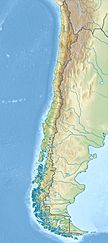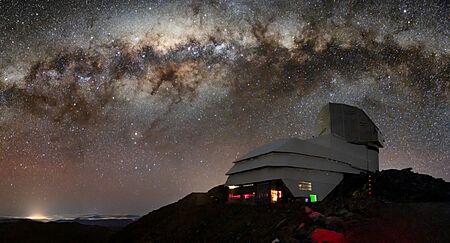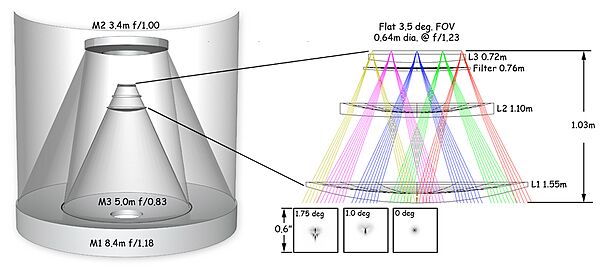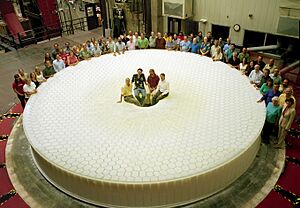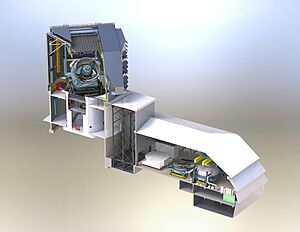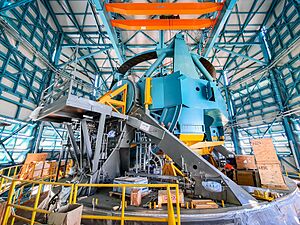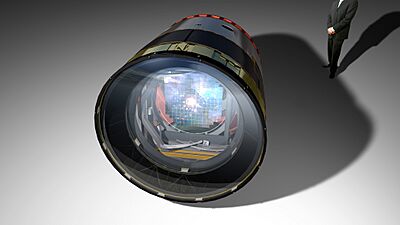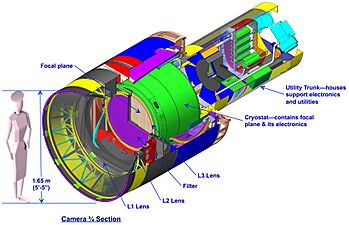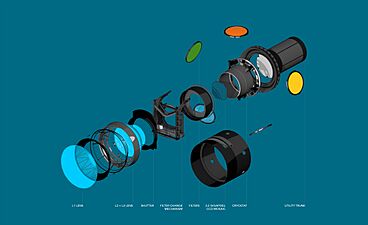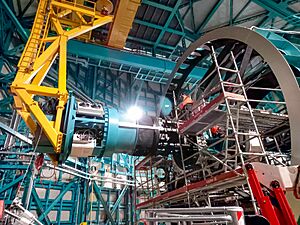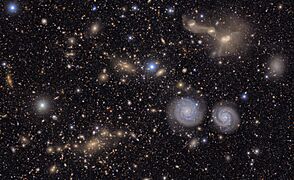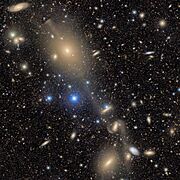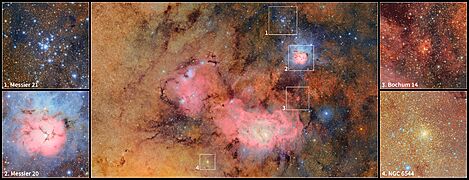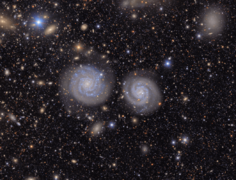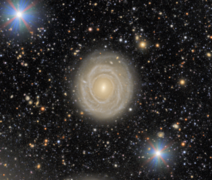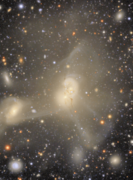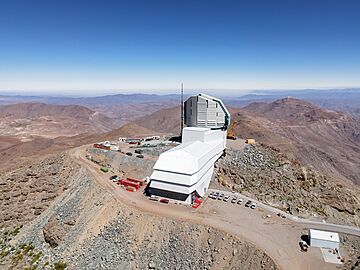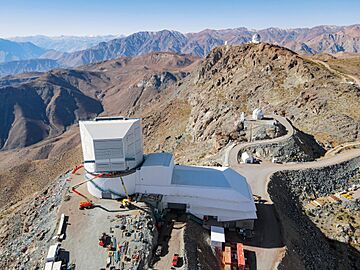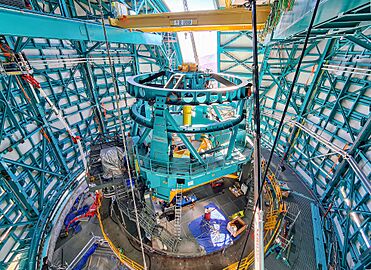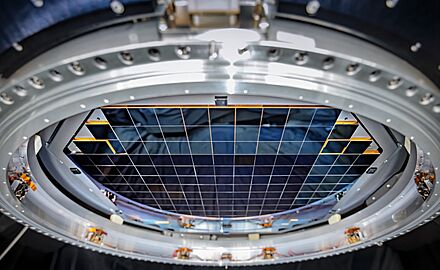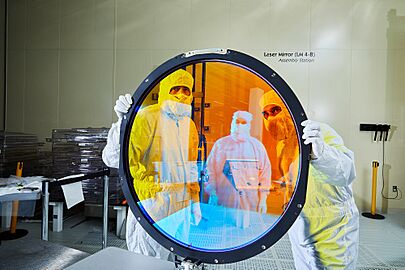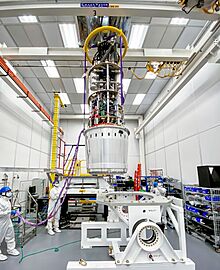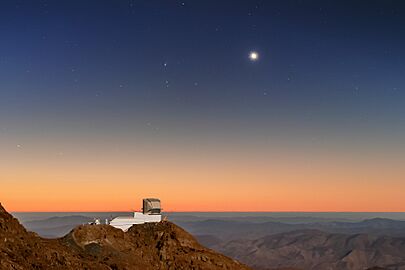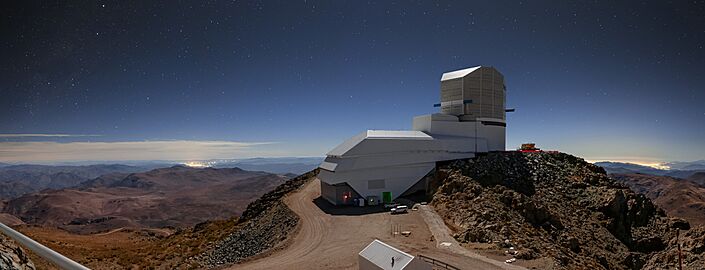Vera C. Rubin Observatory facts for kids
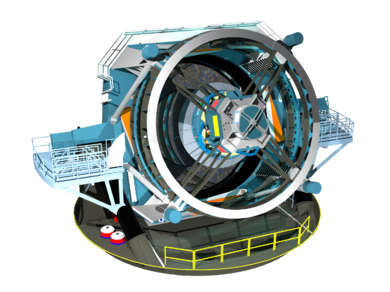
Rendering of completed LSST
|
|
| Alternative names | VRO |
|---|---|
| Named after | Vera Rubin |
| Location(s) | Elqui Province, Coquimbo Region, Chile |
| Coordinates | 30°14′41″S 70°44′58″W / 30.24464°S 70.74942°W |
| Observatory code | X05 |
| Altitude | 2,672.75 m (8,768.9 ft) |
| Wavelength | 320 nm (940 THz)–1,060 nm (280 THz) |
| First light | June 2025 |
| Diameter | 8.417 m (27 ft 7.4 in) |
| Secondary diameter | 3.420 m (11 ft 2.6 in) |
| Tertiary diameter | 5.016 m (16 ft 5.5 in) |
| Angular resolution | 0.7 median seeing limit 0.2 pixel size |
| Collecting area | 35 m2 (380 sq ft) |
| Focal length | 10.31, 9.9175 m (33 ft 9.91 in, 32 ft 6.45 in) |
| Website | rubinobservatory |
| |
|
The Vera C. Rubin Observatory is a special observatory in Chile. It was once known as the Large Synoptic Survey Telescope (LSST). Its main job is to take pictures of the entire southern sky every few nights. This will create a huge, ten-year long time-lapse movie of space, called the Legacy Survey of Space and Time (also known as LSST).
The observatory is built on a mountain called Cerro Pachón in northern Chile. It's near other telescopes like Gemini South. The main building for the observatory is in the city of La Serena, about 100 kilometers (62 miles) away. The observatory is named after Vera Rubin, a famous American astronomer. She made important discoveries about how galaxies spin. This project is a team effort by the U.S. National Science Foundation (NSF) and the U.S. Department of Energy.
Inside the Rubin Observatory is the Simonyi Survey Telescope. This telescope has a huge 8.4-meter (27.5-foot) main mirror. It can photograph a very wide area of the sky. The telescope uses a special design with three mirrors to make sure the images are super clear. The pictures are taken by a 3.2-gigapixel camera. This is the biggest digital camera ever built!
The idea for the Rubin Observatory started in 2001. Building the main mirror began in 2007. The project officially started construction on August 1, 2014. Money for the observatory comes from the NSF, the U.S. Department of Energy, and private donations. The total cost to build it was about $680 million.
Construction at the site started in April 2015. The first test images from the telescope were taken in October 2024. The first official images from the full telescope and camera were released on June 23, 2025. Full operations for the survey are planned to begin later in 2025. The data collected will become public after two years.
Contents
What's in a Name?
The telescope was first called the "Large Synoptic Survey Telescope." The word synoptic means "seeing things together" or "getting a broad view." In June 2019, the observatory was renamed the Vera C. Rubin Observatory. This change became law in the United States on December 20, 2019.
The name honors Vera Rubin. She and her team helped us learn about dark matter. They did this by mapping and cataloging billions of galaxies over time.
The telescope itself is called the Simonyi Survey Telescope. It's named after private donors, Charles and Lisa Simonyi. The old name, LSST, is now used for the survey itself. It's called the "Legacy Survey of Space and Time." The camera is known as the "LSST Camera."
How the Observatory Works
The Simonyi Survey Telescope is special because it has a very wide view of the sky. It can see an area 3.5 degrees wide. To compare, the Sun or Moon look about 0.5 degrees wide from Earth. This wide view, combined with its large mirror, makes it very powerful.
Telescope Mirrors
The telescope uses three mirrors that are not perfectly round. This design helps create very sharp images across a wide area. The main mirror (M1) is 8.4 meters (27.5 feet) wide. The second mirror (M2) is 3.4 meters (11.2 feet) wide. The third mirror (M3) is 5.0 meters (16.4 feet) wide.
The main and third mirrors are made from one piece of glass. This makes the telescope shorter and stronger. It also helps the telescope settle quickly after it moves.
The telescope also has three special lenses to make images even clearer. These lenses are part of the camera. The first lens is 1.55 meters (5 feet) wide. It is the largest lens ever built!
The Camera
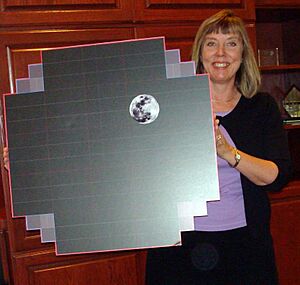
The camera takes 30-second pictures. It has 3.2 billion pixels! This camera is located in front of the main mirror. Moving such a large telescope and camera quickly (within 5 seconds) needs a very strong and stable design.
The camera's flat surface is 64 centimeters (25 inches) across. It has 189 CCD detectors, each with 16 million pixels. These detectors are cooled to about -100 degrees Celsius (-148 degrees Fahrenheit). This helps reduce noise in the images.
The camera also has six color filters. These filters help astronomers see different wavelengths of light. The camera can hold five filters at a time. So, each day, one filter must be chosen to be left out.
How Data is Processed
The camera takes over 200,000 pictures each year. This creates a huge amount of data, more than humans can look at. So, computers are essential to manage and analyze all the information.
Images are processed in three ways:
- Prompt alerts: Within 60 seconds of an observation, the system sends out alerts. These alerts tell scientists about objects that have changed brightness or moved. This quick alert system is very important for finding new events in space.
- Daily products: Within 24 hours, images from the night are released. This includes catalogs of objects found and their orbital information for things in our Solar System.
- Annual releases: Once a year, all the data collected so far is re-processed. This creates very accurate catalogs of stars, galaxies, and objects in our Solar System. It will include about 6 million Solar System objects and 37 billion sky objects.
The Rubin Observatory also sets aside some computing power for users. This means scientists can run their own special programs on the observatory's data. This helps them explore the data in new ways.
What Will Rubin Observatory Discover?

The Rubin Observatory will survey about 18,000 square degrees of the southern sky. It will visit each spot about 825 times. This will allow it to see very faint objects.
The main goals of the Rubin Observatory include:
- Studying dark energy and dark matter: These are mysterious parts of our universe. The observatory will look at how light bends around massive objects (called weak gravitational lensing) and study exploding stars (supernovae).
- Mapping small objects in our Solar System: It will find many new near-Earth asteroids and objects in the Kuiper belt. It's expected to increase the number of known objects by 10 to 100 times! It will also help in the search for the hypothesized Planet Nine.
- Detecting changing events in space: This includes finding new novae, supernovae, and other sudden events. It will send out quick alerts so other telescopes can study them.
- Mapping the Milky Way: It will create a detailed map of our own Milky Way galaxy.
Because it can see a wide area and is very sensitive, the Rubin Observatory is great for finding light from gravitational wave events. These are ripples in space-time detected by observatories like LIGO.
Scientists also hope that the huge amount of data will lead to unexpected new discoveries. The observatory has a program to share its discoveries with the public and educators. It will also partner with Zooniverse for citizen science projects. This means you might be able to help analyze the data!
How it Compares to Other Sky Surveys
Many other telescopes have surveyed the sky. Here's how the Rubin Observatory compares:
- Older photographic surveys: Like the Harvard Plate Stacks (started in the 1880s) and the National Geographic Society – Palomar Observatory Sky Survey. These used film and were not as deep or clear as modern digital surveys.
- Optical Gravitational Lensing Experiment (OGLE): This survey (since 1992) looks for changes in brightness of stars in our galaxy and nearby galaxies.
- Sloan Digital Sky Survey (SDSS): This survey (2000–2009) mapped a large part of the northern sky. It used a 2.5-meter telescope.
- Pan-STARRS: This ongoing survey (since 2010) uses two telescopes in Hawaii. Until the Rubin Observatory started, it was the best at finding near-Earth objects.
- DESI Legacy Imaging Surveys: This survey (since 2013) looks at distant galaxies in both the northern and southern skies.
- Gaia: This space telescope (2014 to March 2025) mapped the entire sky with extreme precision. It measured the exact positions of billions of stars and other objects.
- Zwicky Transient Facility (ZTF): This survey (since 2018) is similar to Rubin Observatory. It quickly scans a very wide area to find sudden events in space. It helps test the alert system for Rubin Observatory.
Building the Observatory
The mountain Cerro Pachón was chosen as the site in May 2006. It was picked because it has many clear nights and good viewing conditions. It also had existing observatory buildings and access to fast internet. This is important for sending the huge amount of data (30 terabytes each night!).
In March 2020, work on the observatory was paused due to the COVID-19 pandemic. However, work on the software continued. The special camera used for testing arrived in August 2022.
Making the Mirrors
Making the main mirror was a huge job that took seven years. It was made by the University of Arizona's Steward Observatory Mirror Lab. The mirror was cast in March 2008. It was polished and finished in 2015. In May 2019, it arrived at the summit in Chile. In April 2024, it was coated with a special reflective layer.
The secondary mirror was also made from special glass. It arrived in Chile in December 2018 and was coated in July 2019.
The Building and Dome
Building the observatory started in March 2011. The main building was mostly finished by March 2018. The dome, which protects the telescope, started rotating on its own in November 2019.
Telescope Mount
The telescope mount is the structure that holds the telescope. It's designed to move the telescope very quickly and precisely. It can move 3.5 degrees to a new spot and settle in just four seconds. This is very fast for such a large structure! The mount was finished in 2018 and arrived at the site in September 2019. By April 2023, the mount was ready for the telescope.
Building the Camera
The LSST Camera project is funded by the U.S. Department of Energy. Construction began in August 2015. By September 2020, the entire camera's pixel array was complete and being tested. The camera was cooled to its operating temperature in November 2021.
A smaller test camera was used first to help set up the telescope. The main camera was reported complete in early 2024. It arrived at the observatory in May 2024 and was installed in March 2025.
Data Transfer
The huge amount of data from the camera must be sent very quickly. It goes from the mountain top to the base facility, then to a data center in California. This transfer needs to be super fast (100 gigabits per second or more). This is because alerts about new events need to be sent out in real-time.
The data travels through fiber optic cables from Chile to Miami, Florida. Many different groups work together to make sure this data transfer is smooth and reliable.
Satellites in the Sky
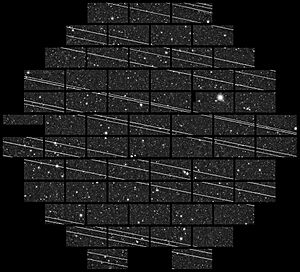
When the telescope takes a long picture, satellites can cross its view. This leaves streaks on the images. It's possible to remove these streaks, but the part of the image where the streak was becomes less useful for science.
Many companies are launching thousands of satellites into low Earth orbit (LEO), like Starlink. This has raised concerns about how these satellites might affect astronomical images.
Scientists at Rubin Observatory have studied this problem. They found that if they change how the telescope moves, they could reduce the number of streaks. However, this would mean losing about 10% of the observing time. Even with many satellites, only a small part of the images would be affected. Satellites in LEO often pass into Earth's shadow during the night. This makes them invisible to telescopes. So, only images taken during or shortly after twilight are expected to be affected by satellite streaks.
Images for kids
Observations
Observatory
-
Comet Leonard, the Rubin Observatory, the planet Venus, and various stars
See also
 In Spanish: Observatorio Vera C. Rubin para niños
In Spanish: Observatorio Vera C. Rubin para niños
- List of largest optical reflecting telescopes
- VISTA (Visible and Infrared Survey Telescope for Astronomy)
- VLT Survey Telescope


